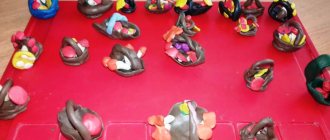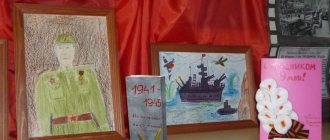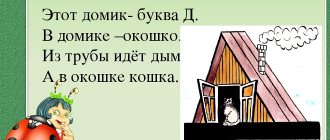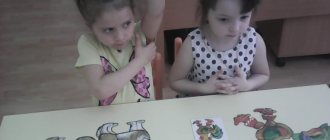Children in preschool age play and communicate a lot. It is during the period of increased interest of the child in communication that it is important not to miss the moment of development of competent, coherent speech. When talking with a child, pay attention not only to the correct use of words, but also to the logical sequence of his story. The development of speech and figurative thinking in preschool age turns out to be more important than teaching a child to read. Moreover, the educational system “Primary School of the 21st Century” does not require reading skills when entering first grade. But any school welcomes children with developed memory, logical and imaginative thinking and developed speech. Story pictures, a little time and parental patience will help develop all this.
Subject pictures - small stories
Story pictures can be one picture or a series of pictures united by meaning. For older preschoolers, pictures are suitable that show not only some action of the character in the illustration, but also contain many details. It’s not easy to compose a story based on one picture even for a junior schoolchild, and not all children can be interested in this activity. Another thing is a series of plot pictures. There can be from three to five to seven. There are picture books where the story is presented only with pictures in a certain sequence. They perfectly develop coherent speech and attention of the child.
But still, a series of individual pictures is more functional. When used in developmental classes, the child will learn to compose a coherent story through the use of logical thinking.
Find out your child's level of preparation for school
Story pictures on speech development
In this section you can download ready-made sets of plot pictures for composing stories. Each set includes two or three pictures connected by a common plot or cause-and-effect relationships. Learning to compose stories based on one picture or a series of plot pictures promotes the development of coherent speech in children of preschool and primary school age. Looking at pictures develops a child's attention. By composing a story from pictures, the child develops thinking when he tries to understand their content, cause-and-effect, spatio-temporal, logical connections between the events depicted on them.
Download and print the assignment form. Cut it with scissors along the dotted lines. Ask your child to arrange the pictures into several sets, as logic dictates. After this, the child must determine the correct sequence of pictures for each set and compose a story based on them. But don’t rush to correct your child if, in your opinion, he has arranged the pictures incorrectly. Listen to his story first, maybe his logic will seem quite convincing to you. You should be alert if: 1. the child could not detect any connection between the pictures; 2. the child was often distracted from the topic of the story, did not highlight the “main” events, or there were many repetitions in the story; 3. the child only listed the objects in the pictures, used separate, short (non-extended) sentences; 4. The meanings of words were approximate; the child rarely used adjectives, adverbs, or words of a general nature.
ATTENTION!
All cards are prepared in pdf format. Typically, most computers already have the free Adobe Reader installed, which you can use to open and print the cards. If for some reason you do not have this program, please visit the ADOBE website here
Form 1
Download and print the assignment form. The form shows two pictures, for each of them the child must come up with and tell a short story.
Form 2
Download and print the assignment form. Cut it with scissors along the dotted lines. Ask your child to arrange the resulting cards into three sets (two cards in each set), as logic dictates. If a child makes a mistake, do not rush to correct him immediately, first listen to his version. After this, the child must determine the correct sequence of cards for each set and write a short story based on them.
Form 3
Download and print the assignment form. Cut it with scissors along the dotted lines. Ask your child to arrange the resulting cards into three sets (two cards in each set), as logic dictates. If a child makes a mistake, do not rush to correct him immediately, first listen to his version. After this, the child must determine the correct sequence of cards for each set and write a short story based on them.
Form 4
Download and print the assignment form. Cut it with scissors along the dotted lines. Ask your child to arrange the resulting cards into three sets (two cards in each set), as logic dictates. If a child makes a mistake, do not rush to correct him immediately, first listen to his version. After this, the child must determine the correct sequence of cards for each set and write a short story based on them.
Form 5
Download and print the assignment form. Cut it with scissors along the dotted lines. Ask your child to arrange the resulting cards into three sets (two cards in each set), as logic dictates. If a child makes a mistake, do not rush to correct him immediately, first listen to his version. After this, the child must determine the correct sequence of cards for each set and write a short story based on them.
Form 6
Download and print the assignment form. Cut it with scissors along the dotted lines. Ask your child to arrange the resulting cards into two sets (three cards in each set), as logic dictates. If a child makes a mistake, do not rush to correct him immediately, first listen to his version. After this, the child must determine the correct sequence of cards for each set and write a short story based on them.
Form 7
Download and print the assignment form. Cut it with scissors along the dotted lines. Ask your child to arrange the resulting cards into two sets (three cards in each set), as logic dictates. If a child makes a mistake, do not rush to correct him immediately, first listen to his version. After this, the child must determine the correct sequence of cards for each set and write a short story based on them.
Form 8
Download and print the assignment form. Cut it with scissors along the dotted lines. Ask your child to arrange the resulting cards into two sets (three cards in each set), as logic dictates. If a child makes a mistake, do not rush to correct him immediately, first listen to his version. After this, the child must determine the correct sequence of cards for each set and write a short story based on them.
Form 9
Download and print the assignment form. Cut it with scissors along the dotted lines. Ask your child to arrange the resulting cards into two sets (three cards in each set), as logic dictates. If a child makes a mistake, do not rush to correct him immediately, first listen to his version. After this, the child must determine the correct sequence of cards for each set and write a short story based on them.
Form 10
Download and print the assignment form. Cut it with scissors along the dotted lines. A series of pictures to establish spatial relationships between objects. To develop the ability to determine the position of an object in relation to another object. Pictures for the following spatial relationships: on, under, behind, in front, on the right, on the left.
Form 11
Download and print the assignment form. Cut it with scissors along the dotted lines. A series of pictures to establish spatial relationships between objects. To develop the ability to determine the position of an object in relation to another object. Pictures for the following spatial relationships: next to, in, behind, between, in front of, on.
It will be interesting for everyone!
What's the best way to work with story pictures? To do this you need:
- lay out the pictures in front of the child;
- look at each picture and talk with your child about what they have in common;
- ask the child to arrange the pictures in the correct sequence;
- ask questions about the plot so that the child gives a complete answer to them.
Next, the child composes a short story on his own.
For a better understanding, let's look at an example. Let's turn to the series of pictures that make up the fairy tales of the wonderful children's writer and illustrator Vladimir Suteev: a series of pictures about children who were picking mushrooms in the forest and were scared when they saw sparkling eyes in a hole under a tree. They imagined that there was a terrible beast there, and, throwing the basket, ran away. A hunter was walking towards them. The guys told him about the terrible beast and, together with the hunter, went to that very tree. The hunter raised his gun and approached the hole in which the animal was sitting. But a small black kitten came out of the hole. The guys were very surprised.
- First, look at the picture and find the characters in the story. Do this with each picture - it is important that the child makes sure that a number of pictures are united in meaning.
- Then for each picture: who is shown in it? Why did the guys come to the forest? What did the guys see? How did you react? What did they do after that? Who was behind the bush? How did the guys behave then?
- Try to get your baby to answer as completely as possible, not limiting himself to one word.
- Now ask the child, looking at the pictures, to tell you in order everything that he saw and remembered. Thus, the baby got a story.
To make it more interesting for your preschooler, include a game moment: tell your version of the story and ask your child to evaluate your story.
Class
Subject. Development of coherent speech
Goal: learning to retell; expansion and activation of vocabulary; formation of an internal retelling plan; development of attention, memory, logical thinking.
Equipment:
magnetic board (composition board); subject picture “Summer” and subject pictures: Masha, house, flowerbed, chickens, rooster, cow, kitten; card with exclamation mark.
Note. Teachers should supplement the set of pictures with a card with an exclamation mark, which will indicate sentences reflecting the assessment of events and attitude to what is happening. For example: Masha likes to relax with her grandmother. “What a beautiful fish.” - thought Masha. Goodbye! and so on.
Progress of the lesson
The teacher attached pictures from top to bottom, one under the other, to a magnetic board (typesetting board), and read the text:
- The long-awaited summer has come. Masha went to visit her grandmother in the village. Grandma has a big beautiful house. Under the windows there is a flower bed with flowers. Variegated chickens roam around the yard. An important rooster is watching over them. The cow Zorka moos for a long time. A small gray kitten yawns and squints on the porch. Masha likes to relax with her grandmother.
Pointing to each picture in turn, the teacher asks the children to remember what was said in each sentence. Then the children retell the entire text in a chain. At the end of the retelling, the teacher turns the pictures over one by one and invites one of the children to reproduce the content of the story.
This arrangement of pictures is explained by the fact that at subsequent stages not only object pictures (denotations) are used, but also graphic schemes of sentences.
Note. If difficulties arise, the child can turn the picture over and, using visual support, restore the content of the sentence.
After a successful retelling, you can turn all the pictures over. The number of cards on the board will correspond to the number of sentences in the text.
Note. Please note that the texts will contain sentences with homogeneous members. In this case, two pictures can be located in one row. And the number of sentences in the text will correspond to the number of rows of pictures. At the end of the lesson or the next day, a more complex type of work is carried out. Pictures for the story are displayed in free order on the board. The teacher reads the text and after reading asks one of the children to arrange the pictures in the desired sequence. All children help and monitor the correctness of the task. After which you can repeat the retelling of the entire text again.
About benefits and effectiveness
A series of plot pictures, as mentioned earlier, gives a universal effect, developing coherent, literate speech, imaginative and logical thinking.
- Logical thinking.
By looking at a series of pictures, a preschooler learns to identify a generalizing link in them and, on this basis, to conclude that the pictures are united by a storyline. In this way, analytical thinking is formed, as well as logical construction, with the help of which children compose a coherent story.
- Creative thinking.
Without imagination, it is basically impossible to compose a story from a picture. Let's say a series of pictures is dedicated to a hedgehog who found a balloon. The child will wonder: where did this same ball come from in the forest? This is where fantasy and imagination come to the rescue: friends were walking through the forest for a birthday party and missed one of the balloons.
- Coherent, literate speech.
It is formed from the age of 4–6 years, when a child can answer a question with a full, expanded sentence with homogeneous members. For its successful formation and training, a series of plot paintings will be very useful. The practice of composing stories, when there are clues in the form of pictures before your eyes, will help your child answer questions competently and coherently, paying attention to the details of what is happening.
Story pictures for writing descriptive stories. The world of plants and mushrooms. Animal world
The manual offered to your attention consists of 22 demonstration plot pictures on topics covering the content of knowledge of the surrounding world: the world of plants and fungi (fruits, vegetables, berries, mushrooms, flowers, trees, forest); the animal world (domestic and wild animals and birds of the Central zone; animals and birds of cold and hot countries; insects, amphibians, reptiles, fish); the human world (a person and his body, a person and his family, planet Earth, country, homeland, capital, city, street, house, transport, apartment, furniture, dishes, food, clothing, shoes, hats, professions); Seasons). The child not only describes objects based on a demonstration picture without relying on specific questions, but also tells what time of year it is, what natural phenomena can be observed, what people do, what clothes they wear, how animals and birds behave, what they eat, what happens to plants, how they grow and develop, etc. It is important that the preschooler, completing the task according to a given scheme, thus learns the relationship between nature and man and reflects the inextricability of this relationship in his story. As a handout for writing a descriptive story, offer him the same picture, but in a smaller format*. If a child finds it difficult to independently compose a story based on a plot picture without relying on questions, you should conduct additional lessons with him, orienting him to a coherent story based on the picture using sample questions, which are given in two versions in the tab on p. 3. Sample questions apply to all 22 pictures in the manual. You can also offer your own options for questions, specifying them. Try to arrange such questions logically from the general to the particular or, conversely, going from the particular (individual subject) to the general (generalization). Extensive picture material can be used to test the mastery of children of this age category (6-7 years) with an accessible lexical dictionary on natural history, social science, and everyday topics, when organizing cognitive activities for its mastery by children of younger ages or in primary school. The subject matter and clarity of the pictures, the content of sample questions on them comply with the requirements of the Federal State Educational Standard for preschool education and existing programs for the upbringing and education of children. The manual is addressed to kindergarten teachers, primary school and foreign language teachers, parents, and tutors. Compiled by: Shesternina N. L.
Tips for parents
We all know that in the early stages of development, a child learns what interests him. In order for the process of learning storytelling from story pictures to be both useful and interesting, you should adhere to some rules:
- Make sure that the sentences in your child’s story are clear and complete.
- Ask more questions, show your interest.
- Try to be active and respond quickly to your child’s answers.
- Write down the resulting sentences, so the baby’s story will become clear.
- You should not correct your child if he talks about the topic of the pictures. But if the baby gets carried away and is just chatting in vain, it is necessary to direct him to the subject of the story.
- If you have just started working with story pictures, then start with a short story.
- To immediately interest your child in such activities, try starting with funny pictures. Children love humor as much as adults and will be happy to tell you a funny story.
And of course, parents of young storytellers need to remember patience and tact. Over time, the baby will learn everything, even if it may take him a little longer than his peers.
Sofia Rogozinskaya





